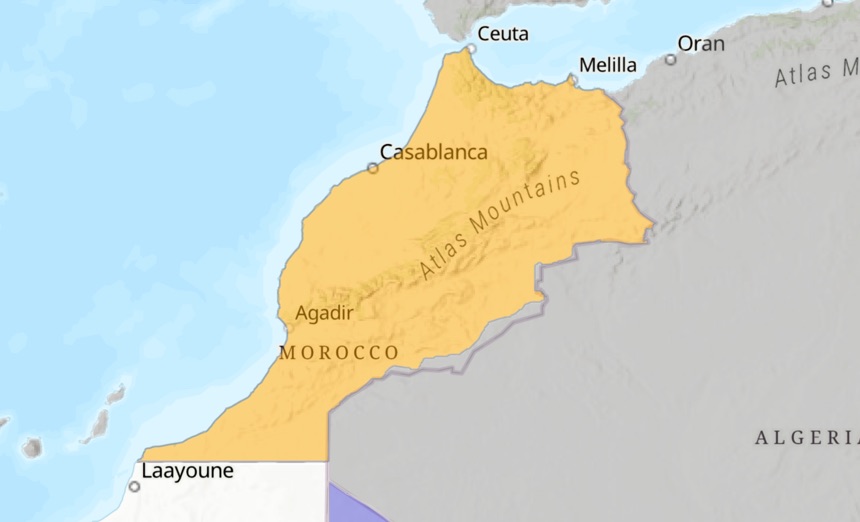Morocco gained independence from France in 1956. The country experienced political instability during the 1960s and 1970s, several coups attempts, and riots.1 Morocco has occupied Western Sahara – which is the subject of a dispute between Morocco and Western Sahara’s indigenous Saharawi people represented by the Polisario Front – since 1975.2 Following 16 years of confrontation, the UN negotiated a ceasefire in 1991, which was accepted by both sides.3 Nevertheless, Morocco continues to have a heavy military presence in Western Sahara and, in 2020, the conflict escalated; armed attacks by the Polisario Front against Moroccan forces in Western Sahara and southern Morocco restarted in response to Moroccan armed forces crossing the UN buffer zone.4 Smuggling activities and small arms and light weapons trafficking in the region also make the country vulnerable to further armed violence.5
The country’s guiding gun control legislation includes the Decree of 1937 regulating the import, trade, carrying, possession and storage of arms and ammunition.6 The United States provides the country with equipment and other assistance aimed at enhancing its security and defence.7
1 Tim Lambert, “A History of Morocco,” Local Histories, March 14, 2021, https://localhistories.org/a-brief-history-of-morocco.
2 “Military occupation of Western Sahara by Morocco,” Rule of Law in Armed Conflicts Project (RULAC), Geneva Academy of International Humanitarian Law and Human Rights, updated May 19, 2023, https://www.rulac.org/browse/conflicts/military-occupation-of-western-sahara-by-morocco#collapse2accord.
3 “Western Sahara Profile,” BBC News, September 7, 2021, https://www.bbc.com/news/world-africa-14115273.
4 Hugh Lovatt and Jacob Mundy, “Free to Choose: A New Plan for Peace in Western Sahara,” European Council on Foreign Relations, May 26, 2021, https://ecfr.eu/publication/free-to-choose-a-new-plan-for-peace-in-western-sahara.
5 Francesco Strazzari and Francesca Zampagni, Illicit Firearms Circulation and the Politics of Upheaval in North Africa (Brussels: Flemish Peace Institute, 2017), https://flemishpeaceinstitute.eu/safte/files/project_safte_eu_neighbourhood_north-africa.pdf.
6 Philip Alpers, Michael Picard and Clara Mourlevat, Morocco – Gun Facts, Figures and the Law (GunPolicy.org, Sydney School of Public Health, University of Sydney, 2022), https://www.gunpolicy.org/firearms/region/morocco.
7 “Morocco – Ground Command and Control,” Defense Security Cooperation Agency, August 25, 2022, https://www.dsca.mil/sites/default/files/mas/Press%20Release%20-%20Morocco%2022-12%20CN.pdf.
Launch the country dashboard
Further information
Accidental explosions
Since the Small Arms Survey began collecting data in 1979, no accidental explosions have been reported in Morocco.
Source: “Unplanned Explosions at Munitions Sites (UEMS) Database,” Small Arms Survey, updated December 15, 2021, https://smallarmssurvey.org/database/unplanned-explosions-munitions-sites-uems.
Cases of diversion
A large number of weapons were seized from the Moroccan Army by the Polisario Front during the period 1975–1991.
Source: Strazzari and Zampagni, Illicit Firearms Circulation.
Disposal
In 2009, Morocco reported 22,105 pieces of small arms ammunition to have been destroyed.
Source: “US, Morocco Improve Demining Capability, Work on Center of Excellence,” US Marine Corps, March 23, 2016, https://www.marines.mil/News/News-Display/Article/702464/us-morocco-improve-demining-capability-work-on-center-of-excellence.
Needs
To further enhance safe and secure ammunition management, the following needs have been identified for Morocco:
- Development or refinement of standards and procedures on stockpile management, including:
- the supply of shelving and automatic small arms and light weapons storage warehouse; and
- the training of personnel on new small arms and light weapons storage management techniques.
- Capacity development for the destruction of surplus stockpiles, including:
- the assignment of new-generation mobile cutting means;
- the training of personnel on new demilitarization techniques; and
- participation in seminars on the subject.
Source: Morocco, National Report on the Implementation of the Programme of Action on Small Arms and Light Weapons (PoA) and the International Tracing Instrument (ITI), (New York: Permanent Mission of Morocco to the UN, 2022), https://unoda-poa.s3.amazonaws.com/reports/MAR-French-1235-SUBMITTED.pdf



